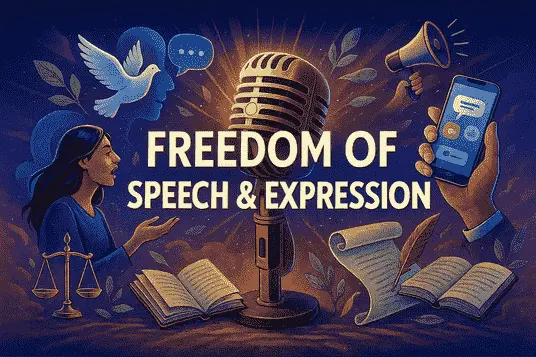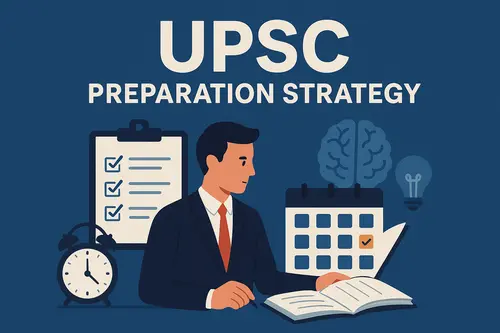
Introduction
Citizens exercise free expression to render their government accountable, to inform citizens, and to participate as actors in the process of nation-building. Article 19(1)(a) of the Indian Constitution provides free expression to every citizen so that every citizen can express opinions in whatever format – written, verbal, visual, audio, online or digital interactive (regrettably, it does not enjoy the same consideration in the absence of speech or expression by disability status).
The freedom of expression creates the condition for truth to occur, dissent to be acknowledged, and new ideas to be imaginatively expressed. However, the framers of the constitution recognized that freedom left unchecked can cause serious harm to social order and public peace and order. This is a great truth, that as important as freedom of speech and expression might be, it is subject to express limitations, as well as other forms of lawful and effective limitations to the right to reasonably limit for the above repression of liberty (i.e., to rationally limit free expression for any pertinent safety, security a public order).
Constitutional Foundation – Article 19(1)(a)
“All citizens shall have the right to freedom of speech and expression.”
This text is the commitment of democratic expression in India – it is the legal commitment to express opinions in open forum, provide criticism to any authority, and to freely express an idea – it is the basis for liberty and to take part in governance.
Nevertheless, this right is not without limits. The authors of the Constitution, being aware of both the diversity of India and the sentiments related to it, included Article 19(2), which permits the State to impose reasonable restrictions on this right that serve a larger public interest.
Grounds for Reasonable Restrictions Under Article 19(2):
- Security of the State – To prohibit speech that either threatens national integrity or potentially results in violence.
- Friendly relations with foreign States – To avoid diplomatic issues resulting from otherwise irresponsible speech.
- Public order – To prevent riots, uprisings and disorder from taking place.
- Decency or morality – To maintain ethical standards/values of society.
- Contempt of court – To maintain the integrity and dignity of the judiciary.
- Defamation – To protect individuals from being harmed by false statements.
- Incitement to an offence – To stop public speech that urges the commission of an illegal act.
- Sovereignty and integrity of India – This was added by the 16th Amendment (1963) after recent Chinese aggression, to ensure that the country’s unity is not imperiled.
Why Is Freedom of Speech Important?
Freedom of speech and expression is not just one right, but rather is the bedrock of all freedoms. Where there is no freedom of speech, a democracy is meaningless, and untruth will continue to prevail.
The freedom of speech goes beyond the right to efficiently freedom of speech goes further. It establishes the basis for all individuals and societies to think, speak and advance freely. This is why freedom of speech is essential to the progression of democratic society.
- Self-discovery – Through open dialogue, individuals can learn about their identity, beliefs and principles.
- Social change – Societies progress by challenging old cultures, biases and injustices.
- Protection of rights – Free speech serves as a barrier to authority, preventing government power from being oppressive.
- Expanding creativity – Art, literature, film and culture can only thrive in a context of free expression.
Expressions of Freedom of Speech
Freedom of expression in India has changed and evolved over time, through judicial interpretation and societal change. Freedom of expression today addresses not just spoken or written words, but also acts, art, digital content and symbolic expression. Let’s examine its major expressions.
a. Freedom of the Press
Though freedom of the press does not appear in the Constitution, it is derived directly from Article 19(1)(a) – as a significant instrument of public discussion and accountability.
Important Judgements:
Indian Express Newspapers v. Union of India (1985) – The Supreme Court held that the freedom of press was a part of freedom of speech.
Bennett Coleman & Co. v. Union of India (1973) – The Court of India held that the freedom of the press also includes the freedom not to be pre-censored or controlled in expression.
Recommendations of the Commission:
The Venkatachaliah Commission (2002) suggested including Freedom of Press in the Constitution to eliminate any uncertainties or ambiguity.
Constitutional Framework:
Article 361A: Provides immunity to anyone for true & fair reporting on parliamentary or state legislature function and activities — this immunity does not extend to secret sessions.
The press is frequently termed the fourth pillar of democracy and if curtailed, this diminishes transparency and accountability, diminishing the voice of the people.
b. Right to Silence
Freedom of speech is a freedom not to speak.
Landmark Case:
Bijoe Emmanuel v. State of Kerala (1986) – also called the National Anthem Case — the Supreme Court upheld the rights of school students not to sing the national anthem because to do so was against their better judgement based on conscience. Here, the Court found that silence is a form of expression.
Today, the right extends to various non-verbal forms of communication, including a gesture, an expression, art, internet memes, social media, or even the refusal to participate — again reinforcing that expression cannot be solely determined by the use of spoken words.
c. Cinematic Expression
Cinema may be viewed as a “complete art form”, shaping thought and influencing millions.
Cinematic expression is governed according to the standards contained in the Cinematograph Act, 1952 — federal law governing the exhibition of cinema film — films are regulated through the Central Board of Film Certification (CBFC).
The Cinematograph (Amendment) Act, 2023 amended the Cinematograph law, as it relates to:
- Piracy
- Digital Exhibitions
- Perceptual value of films in a changing social environment.
Cinematic freedom should be striving to balance artistic imaginative ideas with a sense of social responsibility, ensuring art remains a reflection of our society rather than a tool to divide.
d. Hate Speech
Because speech can empower, it can also divide and undo. Hate speech often undermines the spirit of free speech by creating hostility and fear.
Law Commission 267th Report: Defines hate speech as “an incitement of hatred against a group based on religion, race, gender, and similar identity signs.
Legal Provisions:
- Under the IPC (Old Code): Sections 153A, 295A, and 505 were ways to deal with inflammatory/hate speech.
- Under the Bharatiya Nyaya Sanhita (BNS): Sections 196 & 197 have taken similar provisions into a modernized form.
Judicial Landmarks:
Pravasi Bhalai Sangathan v. Union of India (2014) – The Court stated that existing laws should be better utilized to handle hate speech.
Tehseen Poonawalla v. Union of India (2018) – The Court directed the governments to take preventative steps with regard to mob violence or hate-based crimes.
Digital Age: Changing Meaning of Speech and Expression
In the 21st century, citizens have gone digital with their “voice”—via tweets, reels, memes, podcasts, blogs, and online protests. The internet has democratized delivery of communications so that everyone with a smartphone is potentially a journalist, critic, or activist.
But with this “digital empowerment” comes a whole new set of issues that the Constitution’s Framers could not have contemplated.
Important Issues of the Digital Age:
- Online hate speech and misinformation that are polarizing societies.
- Fake news and algorithmic biases influencing public opinion and elections.
- Government takedown orders that can infringe on personal privacy and dissent.
- Cyber trolling and harassment that can keep some of the most vulnerable voices—especially women and minorities—silent.
Legal Frameworks:
The Information Technology (Intermediary Guidelines and Digital Media Ethics Code) Rules, 2021 gives the government powers to regulate digital platforms, to develop grievance redressal mechanisms, and take down unlawful content.
Many critics have remarked that these powers can become over-regulatory censorship, while many supporters have recognized that they are intended to hold people accountable.
Landmark Judgments:
Shreya Singhal v. Union of India (2015). The Supreme Court of India struck down Section 66A of the IT Act, finding that vague and arbitrary restriction of online speech offends a guarantee of free speech in Article 19(1)(a).
Anuradha Bhasin v. Union of India (2020) – Acknowledged the freedom of access to the internet as a facet of rights to economic livelihood and free speech, and generally stated that there may be a temporary, necessary, and proportional internet shutdown.
New Reality:
The rapid advancement of technology within the digital ecosystem allows speech to travel faster and reach wider audiences, and in turn, alters the obligations that law has regarding the regulation of speech. Accordingly, the challenge of modern democracies is to guarantee that free speech online is guaranteed alongside accountability, data protection, and national security.
The future of free expression lies in balancing the necessary responsibilities with one’s right to an unheard voice in cyberspace.
The Dark Side – Sedition and Preventive Detention
While valuable, guarantees of free speech in article 19 does not rid citizens of some colonial and emergency-time laws that hang over this right. Hence, Two of the most contentious topics at these eras best talks about the dark side of free speech law are sedition and preventive detention.
a. Sedition (S.124A, IPC and now amended S. 150, BNS)
The section criminalizes any conduct, speech, or writing that would bring “hatred or contempt” towards the government. The British introduced the law in 1870 to deter Indian freedom fighters, and now, in various forms continues to govern speech within a contemporary context.
Landmark Case:
Kedar Nath Singh v. State of Bihar (1962) – The Supreme Court found that S.124A was constitutional but a “narrow” interpretation of as long as it can be displayed that a speech led towards incitement leading to violence or public disorder
Finding a Balance between Freedom and Responsibility
Freedom of Speech, Not Freedom from Accountability.
Every right carries with it a responsibility, and the freedom of speech is no different. The right to share one’s thoughts must be balanced with respect for each other’s inherent rights, dignity, and the common good.
The framer’s of the Constitution had a vision of freedom and responsibility, not anarchy. The abuse of speech—whether hate speech, misinformation, or defamation—calls into question the values the freedom is meant to protect.
Judicial interpretation has been consistent in reinforcing the balance. Courts ensure that the freedom of speech is preserved as an institution within democracy, not as a means of anarchy. Justice Patanjali Shastri said in Romesh Thappar v. State of Madras (1950) ,
“Freedom of speech and of the press lay at the foundation of all democratic organizations.”
Therefore, the right to speech must evolve via the integral duty of speaking with truthfulness, purpose, and respect.
UPSC Relevance
For Prelims: Articles 19-22- Fundamental Rights to Individual liberty and Security of the State.
Prominent Commissions:
- Venkatachaliah Commission (2002) – recommended clear references to the freedom of press.
- Law Commission 267th Report – defined and discussed hate speech.
For Mains (GS Paper 2):
- “Discuss the Range and Reasonable Restrictions of Freedom of Speech and Expression in India.”
- “Is Freedom of Speech Under Threat in the Digital Age?”
- “Evaluate the Role of the Judiciary in Protecting Freedom of Speech in India.”
- “How do Hate Speech and Fake News Threaten India’s Democratic Fabric?”
Conclusion: Future of Free Speech
Freedom of Speech and Expression is the lifeblood of democracy; it gives people the strength to question, the right to dissent and the will to reform.
Yet, as India enters the digital age more fully, this freedom faces new tests – Java misinformation, online harassment, algorithmic censorship and shrinking space for dissent. The test is not in fettering the moderating or censoring speech but establishing a culture of responsibility.
The future of free speech must be guided by constitutional morality, digital ethics and civil awareness – balancing liberty and harmony.
“Democracy thrives not when voices are in agreement – but when the agreement is allowed to differ.”
In the end, safeguarding freedom of expression is not the task of courts or governments alone — it is the duty of every citizen who believes that truth and dialogue are the real foundations of a free India.
FAQs on Freedom of Speech and Expression
No, but it is implicitly protected under Article 19(1)(a).
Yes, under Article 19(2) for reasons like public order, morality, or national security.
It struck down Section 66A of the IT Act, upholding online free speech.
Through provisions in the Bharatiya Nyaya Sanhita (Sections 196–197) and judicial oversight.


Pingback: Rights in Uniform: Understanding Articles 33 and 34 - InfoTrigg